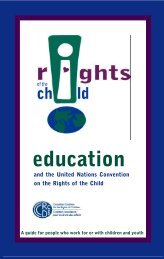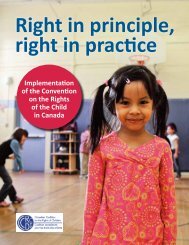Poste - Canadian Coalition for the Rights of Children
Poste - Canadian Coalition for the Rights of Children
Poste - Canadian Coalition for the Rights of Children
Create successful ePaper yourself
Turn your PDF publications into a flip-book with our unique Google optimized e-Paper software.
H O W D O E S C A N A D A M E A S U R E U P ?<br />
Highest level <strong>of</strong> education attained,<br />
all <strong>Canadian</strong>s and Aboriginal <strong>Canadian</strong>s, age 25 and older<br />
Highest level attained All <strong>Canadian</strong>s Adult Aboriginal <strong>Canadian</strong>s<br />
Less than high school diploma 35% 56%<br />
High school diploma 21% 12%<br />
Some college or university 7% 13%<br />
College diploma/certificate 24% 16%<br />
University degree 13% 3%<br />
Source: Statistics Canada, Aboriginal Peoples Post-Censal Survey, 1992 and Labour <strong>for</strong>ce Survey, Revised<br />
estimates, 1995 29<br />
However, more recent data suggests a trend towards<br />
higher educational attainment <strong>for</strong> Aboriginal students. In<br />
1996, 73 percent <strong>of</strong> Aboriginal youth aged 15 to 19 were<br />
attending school. 30<br />
In February 1973, <strong>the</strong> Minister <strong>of</strong> Indian Affairs and<br />
Nor<strong>the</strong>rn Development adopted a policy <strong>of</strong> local control<br />
<strong>of</strong> education so schools could better reflect Aboriginal<br />
histories, languages, values and aspirations. Since <strong>the</strong>n,<br />
various measures have been implemented to advance <strong>the</strong><br />
role and authority <strong>of</strong> Aboriginal peoples in education,<br />
with increasing emphasis on <strong>the</strong> transfer <strong>of</strong> authority and<br />
responsibility to <strong>the</strong>m. The 1996 Royal Commission on<br />
Aboriginal Peoples reiterated <strong>the</strong> longstanding demand<br />
<strong>for</strong> more Aboriginal-controlled education systems. In<br />
Quebec, <strong>the</strong> Inuit, Cree and Naskapi nations now have<br />
<strong>the</strong>ir own school boards. Aboriginal-controlled education<br />
is already in place <strong>for</strong> <strong>the</strong> Nisga’a in British Columbia<br />
and <strong>the</strong> Mi’kmaq in Nova Scotia. 31<br />
Public schools in a number <strong>of</strong> provinces and territories<br />
are establishing long-term policies and directives to<br />
improve educational opportunities <strong>for</strong> Aboriginal<br />
children. Saskatchewan is encouraging greater<br />
participation <strong>of</strong> Aboriginals throughout its public<br />
education system. 32 Alberta’s Native Education Program<br />
funds school boards to work with Indian bands on a<br />
framework <strong>for</strong> developing Aboriginal language and<br />
culture programs and resources. British Columbia has a<br />
Field Services and Aboriginal Education Team and Nova<br />
Scotia has a Council on Mi’kmaq Education and a<br />
81<br />
Mi’kmaq Services Division within<br />
<strong>the</strong> Department <strong>of</strong> Education and<br />
Culture. Manitoba has opened two<br />
public schools with an Aboriginal<br />
focus and has summer institutes on<br />
Aboriginal education to assist<br />
teachers in <strong>the</strong> development <strong>of</strong><br />
Aboriginal perspectives and<br />
education techniques. 33 The<br />
Northwest Territories is developing<br />
and implementing a curriculum that<br />
reflects Dené and Inuit cultures.<br />
The Yukon Education Act<br />
acknowledges <strong>the</strong> importance <strong>of</strong><br />
Aboriginal cultural and linguistic<br />
heritages. 34 The federal government<br />
also has an Aboriginal Head<br />
Start Program to enhance <strong>the</strong><br />
development and school readiness<br />
<strong>of</strong> Aboriginal children. 35<br />
A 1992 <strong>Canadian</strong> Education<br />
Association survey <strong>of</strong> 458 schools in Ontario, British<br />
Columbia, Alberta, Saskatchewan, Manitoba and <strong>the</strong><br />
Northwest Territories found that 65.8 percent <strong>of</strong><br />
respondent schools with Aboriginal students <strong>of</strong>fer<br />
courses with Aboriginal content. In addition to courses<br />
dedicated to First Nations content, many schools had<br />
elements <strong>of</strong> Aboriginal education in <strong>the</strong> regular<br />
curriculum. 36<br />
Provincial/Territorial Curricula<br />
The following is a summary <strong>of</strong> a curricula review<br />
conducted by <strong>the</strong> <strong>Canadian</strong> <strong>Coalition</strong> <strong>for</strong> <strong>the</strong> <strong>Rights</strong><br />
<strong>of</strong> <strong>Children</strong> to assess <strong>the</strong> essential elements <strong>of</strong><br />
education in Canada <strong>for</strong> this research paper.<br />
Development <strong>of</strong> Personality:<br />
The goal <strong>of</strong> education in every jurisdiction is to<br />
develop citizens with healthy, well-rounded<br />
personalities, in<strong>for</strong>med on scientific, ethical,<br />
cultural, geographical, political and social matters<br />
and on <strong>the</strong> arts, so <strong>the</strong>y are prepared to meet <strong>the</strong><br />
myriad challenges <strong>of</strong> <strong>the</strong> rapidly-changing world.<br />
These ef<strong>for</strong>ts are supported by a national program<br />
operated by Lions-Quest to promote <strong>the</strong>




